List of battleships of France
French battleships (French: Cuirassés de la Marine Française) which feature here below, were serviced for the period 1859–1945. Years given are the ships' launch date.
Context and concept
The term Cuirassé appeared prior 1860, first as an adjective, for the construction of the first Cuirassé frigates, before being designated as a class in 1872 during the new classification.
The French Navy has known several axes of development in regards to this type of ship.
- The first generation was battery ships, just like the frigates and others ships which they derived from.
Technical innovations came to reinforce this conception: first a central artillery battery with secondary cannon around, protected in barbettes, a concept which evolved at the expense of the disperse of all artillery in barbettes on the two flancs.
During this period, France developed as well other reduced versions of ironclads for service in the overseas garrisons (such as the corvettes ironclads (French: corvettes cuirasses), for the protection of the colonies as well for floating batteries (French: batteries flottantes) in charge of coastal protection (coastal ironclads (French: garde-côtes cuirassés).
- The pre-dreadnought battleships (French: Pré-Dreadnought), adopted at the end of 1890, had artillery in a diamond disposition.
- Just before World War I, the new program of cuirassés of the dreadnought (French: Dreadnought) was cut short with the beginning of war.
- In the years 1930, France opted for fast battleships to rival German construction.
The French Navy pursued three main lines of development with these ships:
- Large sea-going battleships (battleships of the High Seas). The first generation were broadside ironclads; the next generation were central battery ships with some guns in barbettes to give all round fire. The French then abandoned the central battery in favour of a narrow armoured belt and a main armament in barbettes. Two French battleships Brennus and Charles Martel were abandoned in the 1880s, in part because it was believed that more money should be spent on high-technology weapons such as torpedo boats.[1] The French adopted the lozenge layout in the 1880s and 1890s, and only adopted the 'pre-dreadnought' layout in the late 1890s. Like other powers the French laid down 'dreadnoughts' before the First World War, but their dreadnought programmes were cut short by the war. During the 1930s, the French laid down new fast battleships; the Dunkerque-class battleships were designed to counter the Deutschland-class cruisers and were rivals of the German Scharnhorst class, the Richelieu-class battleships were designed to counter the Italian Littorio class and were rivals of the German Bismarck class. The last French battleship was scrapped in 1970.
- Stationnaire battleships. These were smaller versions of the large battleships, and were often used on foreign stations where they did the job of a battleship. Development of this type was abandoned in the 1880s in favour of armoured cruisers.[1]
- Coastal battleships. The first of these was the steam-powered ironclad 'floating batteries' used to attack Russian fortifications in the Crimean War. More were built in the early 1860s; then they built a series of low freeboard turret and barbette ships, some of which were arguably sea-going battleships.[1]
Battleships of the high seas
Broadside ironclads
- Gloire class 5,603 tons.[2]
- Couronne (1861) 5,983 tons – hulked 1910.[2]
- Magenta class 6,715 tons.[2]
- Provence class 5,700 – 6,122 tons.[2]
- Gauloise class (French: Classe Gauloise)
- Belliqueuse (French: Belliqueuse) (1865) 3,717 tons – expended as a target 1886.[2]
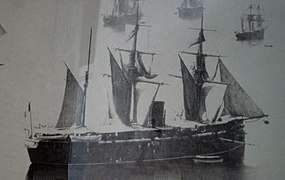 Gloire
Gloire La Gloire
La Gloire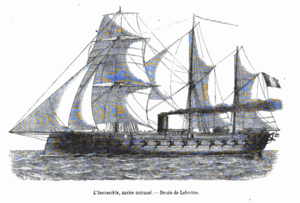 Invincible in 1860
Invincible in 1860 Couronne in 1861
Couronne in 1861 Magenta and Napoléon III
Magenta and Napoléon III.jpg) Solférino in 1861
Solférino in 1861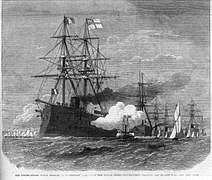 Solférino
Solférino.jpg) Guyenne class in 1865
Guyenne class in 1865.jpg) Belliqueuse in 1865
Belliqueuse in 1865.jpg) Normandie in 1870
Normandie in 1870
Central battery ships with barbettes
- Océan class 7,580/7,775 tons.[2]
- Friedland (1873) 8,850 tons – stricken 1902.[2]
- Richelieu (1873) 8,984 tons – sold 1901, sank in the Bay of Biscay after sale.[2]
- Colbert class 8,750 tons.[2]
- Redoutable (1876) 9,224 tons, first warship in the world to use steel as the principal building material – stricken 1910.[2]
- Dévastation class 10,450 tons.[2]
- Dévastation (1879) – BU 1922.[2]
- Courbet (1882) ex-Foudroyant – stricken 1910.[2][3]
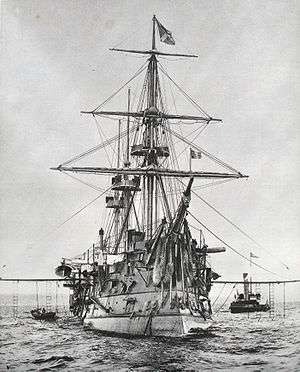 Océan in 1870
Océan in 1870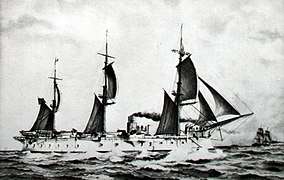 Océan
Océan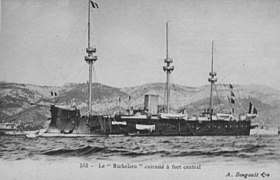 Richelieu
Richelieu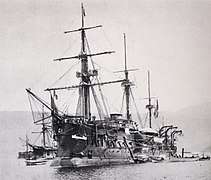 Colbert
Colbert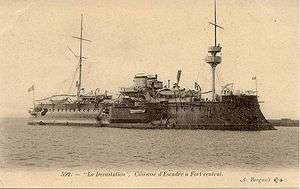 Dévastation
Dévastation.jpg) Redoutable
Redoutable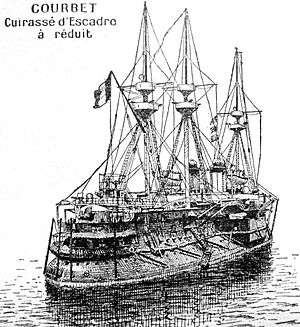 Courbet
Courbet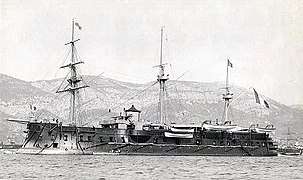 Colbert
Colbert
Stationnaire central battery ships with barbettes
- Alma class (French: Classe Alma) 3,513–3,828 tons.[2]
- La Galissonnière class (French: Classe La Galissonnière 4,585–4,645 tons.[2]
- La Galissonnière (1872) – stricken 1894.[2]
- Triomphante (1877) – sold 1903.[2]
- Victorieuse (1875) – hulked 1900.[2]
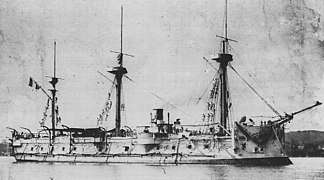 Triomphante of the La Galissonnière class
Triomphante of the La Galissonnière class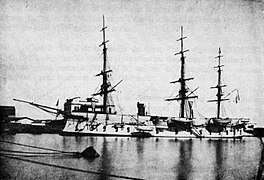 Galissoniére - 1882 - Port Said
Galissoniére - 1882 - Port Said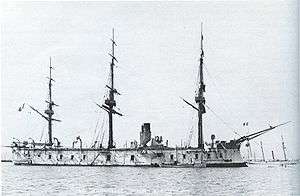 Victorieuse - 1886 - Algiers
Victorieuse - 1886 - Algiers
Barbette ships

- Amiral Duperré (1879) 11,030 tons. Though this ship was designed for sail as well as steam power, her sails were removed before completion.[1] – stricken 1909.[2]
- Amiral Baudin class 11,720 tons,[2] the first French sea-going battleships without any sail power.[4]
- Amiral Baudin (1883) – hulked 1909.[2]
- Formidable (1885) – stricken 1911.[2]
- Hoche (1886) 10,820 tons, turrets & barbettes – target 1913.[2]
- Marceau class 10,558–10,810 tons.[2]
- Charles Martel class 10,600–10,650 tons, slightly enlarged Marceaus.[5]
.jpg) Amiral Duperré
Amiral Duperré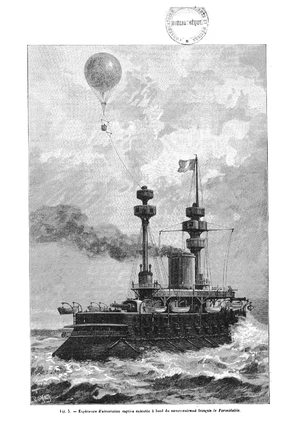 Formidable testing a balloon
Formidable testing a balloon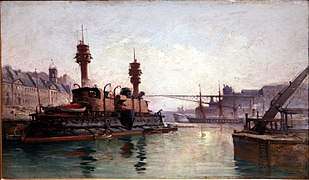 Neptune
Neptune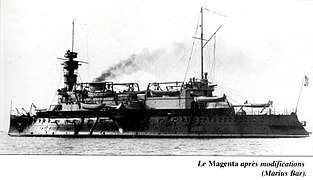 Magenta
Magenta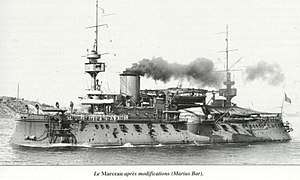 Marceau
Marceau
Stationnaire barbette ships
- Bayard class (French: Classe Bayard) 5,915–6,260 tons.[2] Smaller versions of Amiral Duperré, with full sail power.[1]
- Vauban class (French: Classe Vauban) 6,112 tons. Improved Bayards.[2]
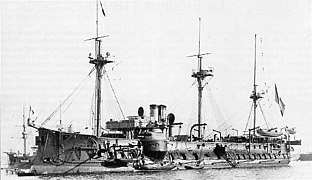 Bayard
Bayard.jpg) A painting by Paul Jazet (1848–1918), featuring a Vauban-class battleship
A painting by Paul Jazet (1848–1918), featuring a Vauban-class battleship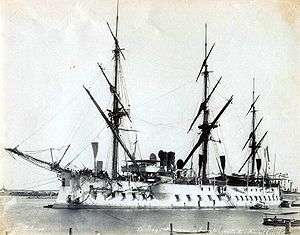 Bayard in Pord Said
Bayard in Pord Said
Turret ships
- Brennus (1891) 11,190 tons, the first large ship with Belleville boilers,[4] – BU 1922.[2]
- Field flotilla (naval program of 1890):
- Charles Martel 11,693 tons – stricken 1922.[2]
- Carnot (1894) 11,954 tons – stricken 1922.[2]
- Jauréguiberry (1893) 11,637 tons – BU 1934.[2]
- Masséna (1895) 11,735 tons – hulked, then scuttled as a breakwater at Cape Helles 1915.[2]
- Bouvet (1896) 12,007 tons – mined 1915.[2]
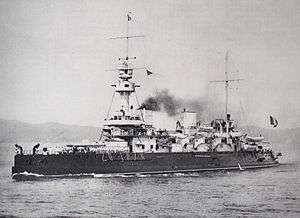 Brennus
Brennus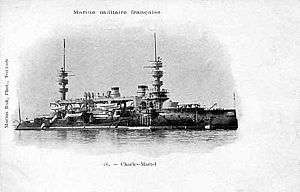 Charles Martel
Charles Martel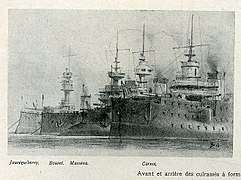 Jauréguiberry, Bouvet, Masséna, Carnot
Jauréguiberry, Bouvet, Masséna, Carnot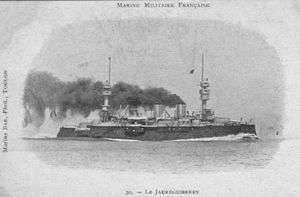 Jauréguiberry
Jauréguiberry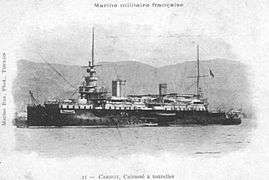 Carnot
Carnot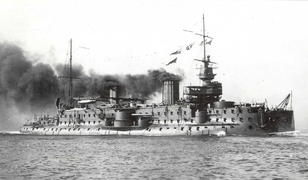 Carnot
Carnot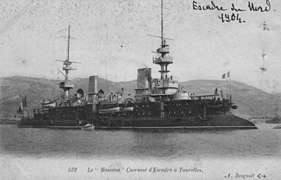 Masséna
Masséna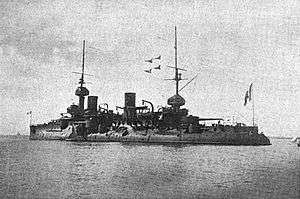 Bouvet
Bouvet
Pre-dreadnought battleships (1895–1910)
- Charlemagne class 11,100 tons.[2]
- Charlemagne (1895) – stricken 1920.[2]
- Saint Louis (1896) – BU 1933.[2]
- Gaulois (1896) – torpedoed 1916.[2]
- Iéna (1898) 11,860 tons – sank after explosion 1907.[2]
- Suffren (1899) 12,527 tons – torpedoed 1916.[2]
- République class 14,605–14,900 tons.[2]
- République (1902) – stricken 1921.[2]
- Patrie (1903) – stricken 1928.[2]
- Liberté class 14,489–14,860 tons.[2]
- Danton class ("semi-Dreadnoughts") 18,318 tons normal, 19,763 tons full load.[7]
- Danton (1909) – torpedoed 1917 in Tyrrhenian Sea.[7]
- Voltaire (1909) – condemned 1935, BU 1939.[7]
- Diderot (1909) – condemned 1936, BU 1937.[7]
- Condorcet (1909) – deleted 1931, scuttled 1942, refloated 1944, sold for BU 1945.[7]
- Mirabeau (1909) – target 1921–22, BU 1928.[7]
- Vergniaud (1910) – deleted 1921, used as target for experiments until 1926, BU 1928.[7]
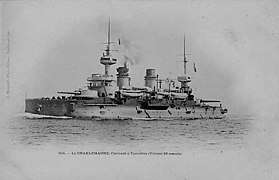 Charlemagne
Charlemagne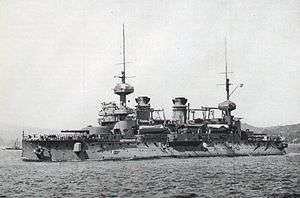 Charlemagne
Charlemagne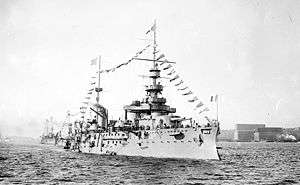 Liberté
Liberté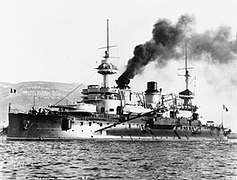 Gaulois in 1900
Gaulois in 1900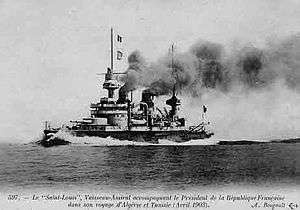 Saint-Louis
Saint-Louis Démocratie in 1904
Démocratie in 1904- Iéna in 1907
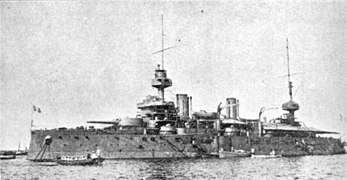 Suffren in 1914
Suffren in 1914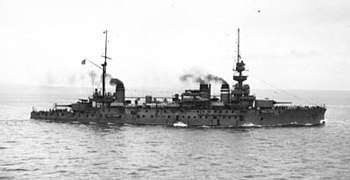 Justice in 1914
Justice in 1914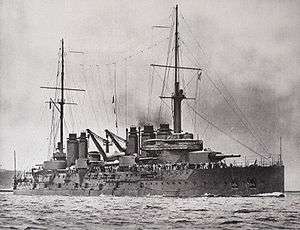 Danton
Danton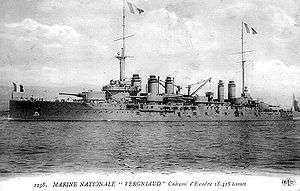 Vergniaud
Vergniaud
Dreadnoughts (1910–1920)
- Courbet class 22,189 tons normal, 25,000–26,000 tons full load.[7]
- Jean Bart (1911) – renamed Océan 1936, disarmed for use as a training ship 1938, used for explosives trials by the Germans and sank 1944,[8] sold for BU 1945,[7] broken up (BU) 1946–47.
- Courbet (1911) – training ship 1939, taken over by Royal Navy 3 July 1940, transferred to Free French and used as AA guardship, scuttled on 9 June 1944 as part of a Mulberry harbour during the Normandy landings.[7][8]
- Paris (1912) – training ship 1939, taken over by Royal Navy 3 July 1940, transferred to Free French and used as accommodation ship, towed to Brest August 1944, used as a pontoon from 1950, sold for BU December 1955,[7][8] BU 1956
- France (1912) – wrecked 1922.[7]
- Bretagne class 25,000 full load.[7]
- Provence (1913) – sunk at Mers-el-Kébir 3 July 1940, refloated, and repaired at Toulon, scuttled November 1942, refloated 1943, scuttled 1944, refloated and BU 1949.[7][8]
- Bretagne (1913) – sunk at Mers-el-Kébir 3 July 1940, salvaged 1952 and BU.[7][8]
- Lorraine (1913) – interned by the British at Alexandria June 1940 – May 1943, then used by Free French, used as training ship 1945–1953, stricken February 1953, BU 1954.[7][8]
- Normandie class 25,230 full load (all except Béarn were cancelled and scrapped after launching).[7]
- Lyon class 29,000 tons full load, planned under 1912 programme, it was intended to place orders with builders in January–April 1915.[7]
.jpg) Jean Bart in 1911
Jean Bart in 1911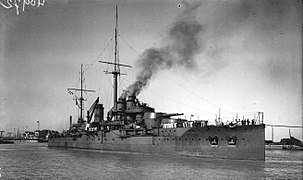 The battleship France in 1914 (Courbet class)
The battleship France in 1914 (Courbet class)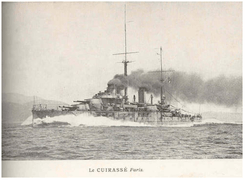 The battleship Paris (Courbet class)
The battleship Paris (Courbet class)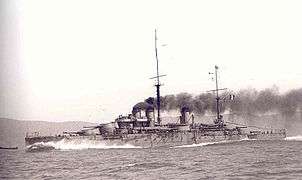 Paris in 1914
Paris in 1914_-_raster.jpg) Bretagne in 1916
Bretagne in 1916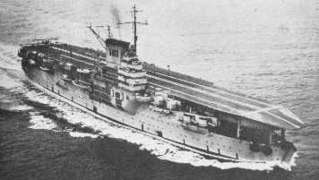 Bearn in 1927
Bearn in 1927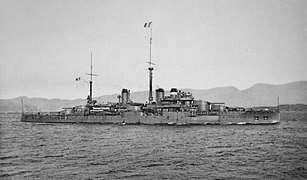 Courbet in 1934
Courbet in 1934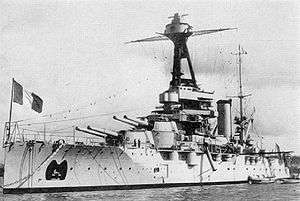 Provence in 1939
Provence in 1939
Fast battleships or super-dreadnoughts

- Dunkerque class 26,500 tons standard, 30,750–31,400 tons normal, 35,500 tons deep load.[8]
- Dunkerque (1935) – sunk at Mers-el-Kébir 6 July 1940, refloated September 1942, scuttled November 1942, refloated 1945, sold for BU 1958.[8]
- Strasbourg (1936) – scuttled November 1942, refloated 1943, sunk 1944, refloated 1945, used as experimental hulk, sold for BU 1955.[8]
- Richelieu class 35,000 tons standard, 43,293–46,500 tons standard, 47,548–49,850 tons deep load.[8]
- Alsace class (two planned but not ordered)[10]
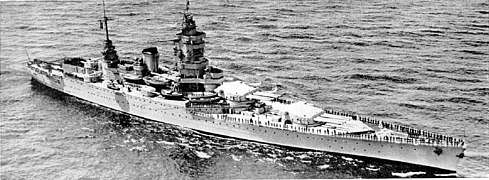 Dunkerque in 1938
Dunkerque in 1938 Dunkerque in 1939
Dunkerque in 1939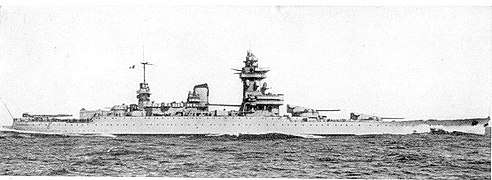 Strasbourg
Strasbourg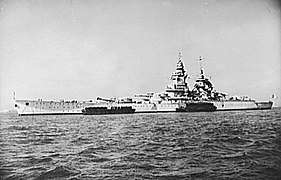 Richelieu arrival to the U.S.
Richelieu arrival to the U.S.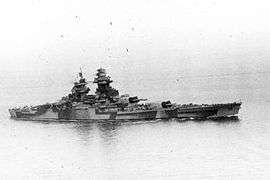 USN recognition slide. Richelieu 1943, after modernizations in U.S.
USN recognition slide. Richelieu 1943, after modernizations in U.S.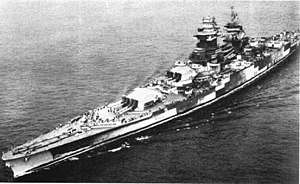 Richelieu in 1943 following modernizations in U.S.
Richelieu in 1943 following modernizations in U.S.
Coastal battleships
Broadside ironclad floating batteries for coastal service
- Dévastation class built for the Crimean War 1,600 tons.[2]
- Palestro class 1,508–1,539 tons.[2]
- Arrogante class 1,412-1.490 tons.[2]
- Embuscade class 1,426–1,589 tons.[2]
- Rochambeau (1865) ex-USS Dunderberg 7,800 tons, purchased 1867 – stricken 1872.[2]
Battleship rams
- Taureau (1865) barbette ship ram 2,433 tons – stricken 1890.[2]
- Onondaga (1863) ex-USS Onondaga 2,551 tons, purchased 1867 – stricken 1904.[2]
- Cerbère class 3,532 tons.[2]
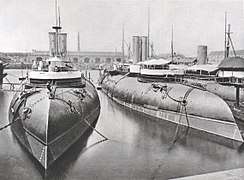 Cerbère and Bélier
Cerbère and Bélier
With turret or barbettes
- Tonnerre class ,1st Class Coastal Battleship, 5,765–5,871 tons.[2]
- Tempête class, 2nd Class Coastal Battleship, 4.635-4,793 tons.[2]
- Terrible class (French: Classe Terrible) or Indomptable class, 7,530 tons.[2] Small battleships based on the Amiral Baudin, and intended for operating in the Baltic in case of war with Germany.[1] The British sometimes considered these to be sea-going battleships,[11] and sometimes coastal service warships.[3]
- Bouvines class 6,681 tons.[2]
- Valmy class 6,476 tons.[2]
- Henri IV (1899) 8,807 tons – stricken 1921.[2][12][13]
.jpg) Tonnant in 1890
Tonnant in 1890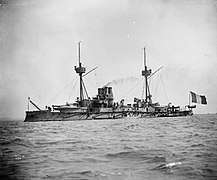 Requin in 1892
Requin in 1892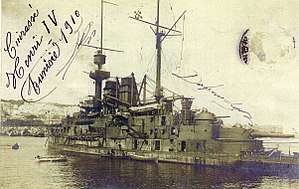 Henri IV in 1910
Henri IV in 1910
See also
Footnotes
- 1 2 3 4 5 6 7 8 9 10 "Ropp, Theodore, The Development of a Modern Navy, French Naval Policy 1871–1904, pub US Naval Institute, 1987, ISBN 0-87021-141-2
- 1 2 3 4 5 6 7 8 9 10 11 12 13 14 15 16 17 18 19 20 21 22 23 24 25 26 27 28 29 30 31 32 33 34 35 36 37 38 39 40 41 42 43 44 45 46 47 48 49 50 51 52 53 54 55 56 57 58 59 60 61 62 63 64 65 66 67 68 69 70 71 72 73 74 75 76 77 78 79 80 81 82 83 84 85 86 87 88 89 90 91 92 93 94 95 96 97 98 99 100 101 102 103 104 105 106 107 108 109 110 111 112 113 114 115 116 117 118 119 120 121 122 123 124 125 126 127 Chesnau, Roger and Kolesnik, Eugene (Ed.) Conway's All the World's Fighting Ships, 1860–1905. Conway Maritime Press, 1979. ISBN 0-8317-0302-4
- 1 2 Brassey, Lord, The Naval Annual 1890, pub Griffin, 1890.
- 1 2 Hovgaard, William, Modern History of Warships, originally published 1920, pub Conway, 1978, ISBN 0-85177-040-1
- ↑ Brassey, Lord, The Naval Annual 1886, pub Griffin, 1886.
- 1 2 Page 86, Brassey, Lord, The Naval Annual 1886,
- 1 2 3 4 5 6 7 8 9 10 11 12 13 14 15 16 17 18 19 20 21 22 23 24 25 26 27 Gardiner, Robert (ed), Conway's All the World's Fighting Ships 1906–1921, pub Conways, 1985, ISBN 0-85177-245-5
- 1 2 3 4 5 6 7 8 9 10 11 12 13 14 Gardiner, Robert (ed), Conway's All the World's Fighting Ships 1922–1946, pub Conways, 1980, ISBN 978-0-85177-146-5
- ↑ U.S. Navy (This image is part of a photograph album kept by Commander Joseph C. Clifton during 1942–1944, which included service as Commanding Officer of Fighting Squadron (VF) 12 and Commander Air Group (CAG) 12.)
- ↑ Jordan, John; Dumas, Robert (2009). French battleships 1922–1956. Seaforth Punblishing. p. 180. ISBN 978-1-84832-034-5.
- ↑ Brassey, Lord, The Naval Annual 1887, pub Griffin, 1887.
- ↑ Described as one of the first battleships to utilize turrets in superfiring mode
- ↑ In 1920, Henri IV became a TSF school-ship (French: navire-école)